Analysing bone, tooth, tusk and antler
Artefacts of bone, tooth, tusk and antler
One of the most numerous material categories from Alvastra pile dwelling is artefacts made of bone, tooth, tusk or antler. Browall (2011:295-332) classifies 19 different types of artefacts made from these raw materials unearthed during Frödin’s investigations. A number of osteologists have been involved in the interpretation and descriptions of the material where Ludvig Hedell (Frödin’s excavations) and Ebba During (Malmer’s investigations) have described the largest portion of the material found at the pile dwelling.
The different materials are presented below as well as the specific categories connected to the raw materials. The text is introduced by an overview of the bone, tooth, tusk and antler artefacts found during Frödin’s investigations followed by an account of the recording of the assemblage produced by Mats P. Malmer’s excavations within the current project, Worth noting is that the artefact categories presented in this text can involve different materials – there are bone, tooth and tusk pendants and bone and tooth awls to name a few material categories that overlap (see recording document for further information).
Otto Frödin’s investigations
There are 873 objects made of bone, tooth, tusk or antler from Otto Frödin’s excavations, these objects have been classified by osteologist Ludvig Hedell and described and interpreted by Browall (2011:295-332; tabell 135-171). The material has been divided into 19 categories: awl, needle, dagger, arrowhead, harpoon, fishing hook, decoration tool, point, chisel, knife, spade, spoon, bead, pendant, stabbing weapon, pressure flaker, punch, as well as worked and unworked bone (Browall 2011: 295).
Of special interest is the suggested connection between the choice of bone elements, animal species and type of artefact; according to Browall there is a correlation that points to a specialized craft at the pile dwelling (see Browall 2011: 295-318). The most striking example of this is Hedell’s analysis of the material, that shows metacarpalia/metatarsalia as the most common choice of bone elements for making awls at the pile dwelling (70 objects) followed by tibia (44 objects), fibula (25 objects) and then ulna (16 objects) together with a few awls made of long bones.
Interestingly enough, the above mentioned bone elements used to make the awls seem to be related to the bone species i.e. deer is most commonly used for awls made of metacarpalia/metatarsalia (41 objects), sheep and hare are equally common for the tibia awls (16 objects), pig/boar for the fibula awls (21 objects) and wild cat for the ulna awls (9 objects; Browall 2011:296). Browall argues that the choices of certain bone elements and animal species were made even though an array of other domesticated and wild animals were available (Browall 2011:296; see 2011:295-318 for further discussion).
The number of artefacts that have been made of either bone, tooth, tusk or antler is vast and displays an array of Neolithic objects. Of special interest are the possible pottery decoration tools unearthed during Frödin’s investigations. Five such objects have been suggested as implements for decoration, one of these artefacts is more plausible than the other four. What is more, the tool is very well crafted (see Hinders 2017 for further details on pottery decoration tools).
Fig. 1. TABLE. Bone, antler, tooth and tusk from Frödin’s excavations (file will be downloaded shortly).
Mats P. Malmer’s investigations
The artefacts made of bone, tooth, tusk or antler from Malmer’s investigations (435 objects) have been recorded in line with previous definitions of the artefacts presented in Browall (2011:295-332). However, fewer types of artefacts were found during Malmer’s investigations when compared to the former; when summarized only 12 artefact categories have been identified within the current project, namely: awl, bone dagger, harpoon, fishing hook, pottery decoration tool, chisel, bead, punch, pendant, bone with worked point, bone with drilled hole and worked bone/tooth/tusk/antler (see section on recording the assemblage from Mats P. Malmer’s excavations).
Fig. 2. Bone, antler, tooth and tusk in the museum database (file will be downloaded shortly).
Analysing the results
The result of recording the many artefacts made of bone, tooth, tusk or antler within the current project shows that artefacts made of bone represent the largest portion of the material (398 objects; 91,5%) followed by antler (16 objects; 3,7%), tusk (12 objects; 2,8%) and lastly tooth (9 objects; 2,1%). Thus, bone clearly stands out as the most prominently used material in the area of the pile dwelling investigated by Malmer, only 35 objects i.e. 8,1% of the material is made of tooth, tusk or antler (see below fig. 3).

Fig. 3 Figure displaying the relations between the different artefact categories made of bone, tooth, tusk or antler within the current project. Figure by Nathalie Hinders.
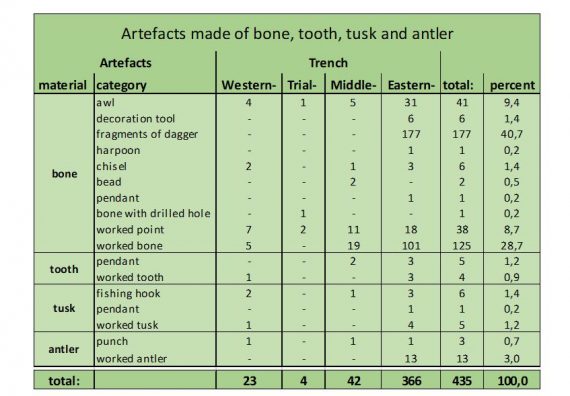
Fig 4. Table displaying the different artefact categories made of bone, tooth, tusk and antler within the current project. Material, type of artefact, total number of artefacts and weight are presented. Table by Nathalie Hinders
Artefacts of bone
The most prominently used raw material is bone, where fragments of bone daggers are most common (177 objects). It is of note that the number of objects represent fragments of bone daggers; the original number of intact daggers is significantly smaller. Worked bone objects (125 objects) is the second largest group, followed by bone awls (41 objects), artefacts with worked point (38 objects), pottery decoration tools (6 objects), chisels (6 objects), beads (2 objects; two halves of the same object see fig 5 below.), bone pendants (1 object) and bone with drilled hole (1 object). The categories that include artefacts with unknown function i.e. artefacts with worked point, bone with drilled hole and worked bone represent 37,7% (164 objects) of the total material of the bone artefacts.
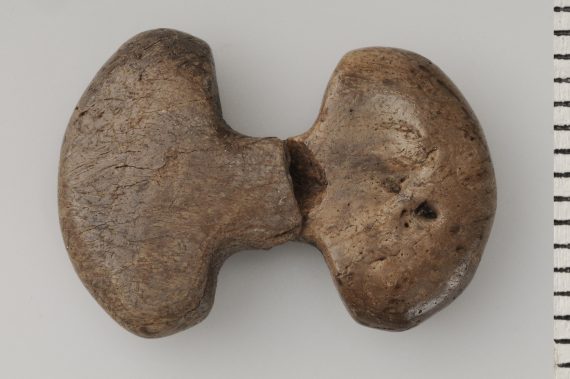
Fig. 5. Object number 1188534. Double-edged-axe shaped bead. Two halves of the same object, Photo: Gabriel Hildebrand, SHM
Artefacts of tooth
9 objects of tooth have been recorded within the current project. 5 objects are defined as pendants and 4 as worked tooth.
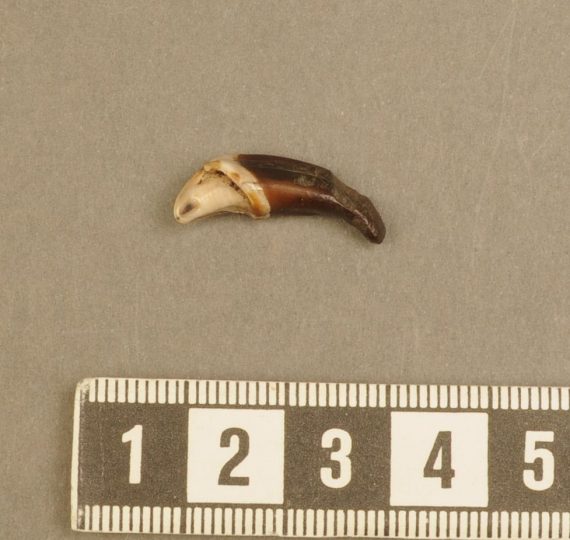
Fig. 6. Object number 1209106. Tooth pendant
Artefacts of tusk
The total number of artefacts made of tusk from boar is 12 objects where fishing hook is the most common category (6 objects), followed by worked tusk (5 objects) and lastly tusk pendant (1 object).
Artefacts of antler
Antler has been used as the second most common raw material of the above discussed materials (16 objects). Most antler objects have been worked (13 objects), for unknown reasons. There are a small number of punches present amongst the antler artefacts (3 objects).
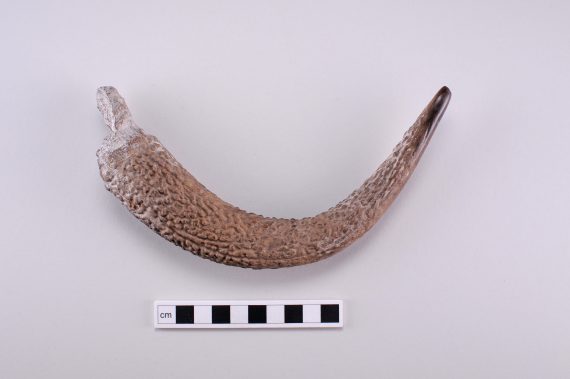
Fig. 7. Object number 1259819 . Punch, antler
Artefact categories
If focus turns to the artefact categories recorded from Malmer’s investigations with no regard to the raw material used, fragments of bone dagger is still the most numerous artefact category (177 objects), closely followed by worked artefacts made from all of the discussed raw materials (147 objects). The other artefact categories disperse as follows: awls (41 objects), bones with worked point (38 objects), pottery decoration tools (6 objects), chisels (6 objects), fishing hook (6 objects), pendant (5 object), punches (3 objects), beads (2 objects), harpoon (1 object), and bone with drilled hole (1 object) (see fig 8. and fig 9 below).
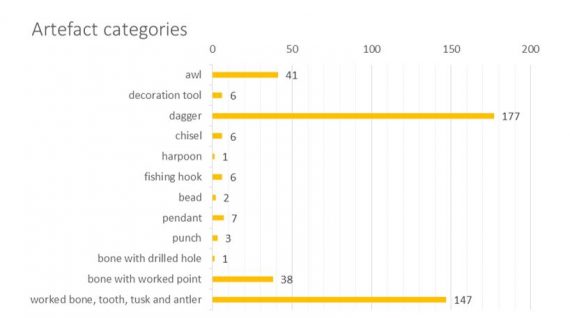
Fig. 8. Table displaying all artefact categories recorded within the current project. The artefact categories are presented together with total number of objects within the category. Table by Nathalie Hinders.
How the material is dispersed within the different trenches
The artefacts discussed above have been scattered in layers within all the trenches: Western, Trial, Middle and Eastern trench. Most of the material was recovered in the Eastern trench (366 objects) representing 84,1% of the total material. The Middle trench contained the second largest material (42 objects) representing 9,7% of the material followed by the Western trench (23 objects) representing 5,3% and lastly the Trial trench (4 objects) representing 0,9% of the total material (see details in fig 9 below). It is worth mentioning that the difference in number between the four trenches means that comparisons between the trenches are made with difficulty. Only the Western- and Middle trench yielded numbers similar enough to make comparative analysis possible. However, the Middle trench contains almost twice as many artefacts as the Western trench. The large number of artefacts in the Eastern trench needs to be discussed further.
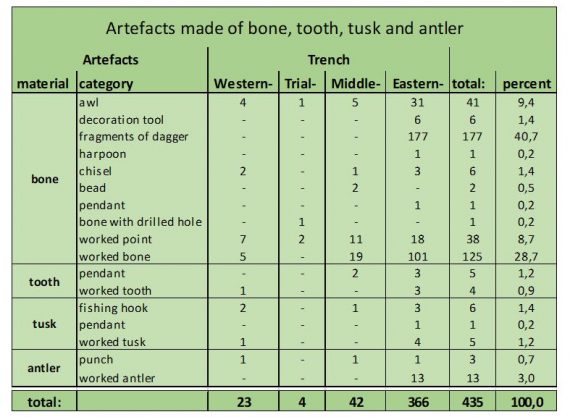
Fig. 9. Table displaying all artefact categories recorded within the current project and how the assemblage is dispersed within the different trenches. Table by Nathalie Hinders.
Text: Nathalie Hinders
The following reference cited on this page has no web link:
Browall, H., 2011. Alvastra pålbyggnad, 1909-1930 års utgrävningar. Kungl. Vitterhets Historie och Antikvitets Akademien. Handlingar. Antikvariska serien 48. Stockholm.